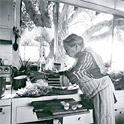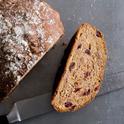To make julienne—small thin square-ended strips—follow the procedure for dice, cutting the slices very thin, from one-sixteenth to one-eighth inch thick, then cut across the bundle of strips to make uniform strips one to one and a half inches long. To make bâtonnets, which are thicker julienne, follow the directions for julienne, but cut the slices one-quarter inch thick and the strips one inch long.
To make paysanne, or thin discs, use small carrots two to two and a half inches long or trim large carrots to this size. Cut a thin slice from one side to make a flat surface, lay the carrot flat side down on the board, and slice across the carrot as thinly as possible.
POTATOES
Follow the directions for carrots, cutting the slices one-half inch thick, more or less, according to the requirements of the particular recipe. Keep peeled potatoes always covered with water to prevent them from darkening.
WHITE TURNIPS
Follow the directions for carrots. For turnips paysanne, cut the turnips in quarters lengthwise and trim the quarters to the shape of carrots, Slice as for carrots paysanne.
CELERY
Wash the celery and scrape off the strings. Cut the stalks in lengths of one or one and a half inches as desired. To dice these lengths of stalks, cut them in strips about as wide as the stalk is thick and cut across the strips to make even dice. To make julienne and bâtonnets, slice the stalks lengthwise, one-sixteenth to one-eighth inch thick for julienne, one-quarter inch thick for bâtonnets.
LEEKS
Leeks usually have quantities of sand hidden between their layers. They require special cleaning as follows:
Cut off the coarse green tops; the undamaged green tops can go into the stock pot. Cut off the roots but leave the base intact. Lay the leek on a board and slice it lengthwise through the center, to within one and a half inches of the base. Turn the leek and slice it again through the center, thus quartering the leek without separating it from the base. Hold the leek under running water from the faucet, rolling it in the hands so that the water flushes out all the sand.
To make dice, julienne, or bâtonnets, lay the leek on a board, cut it in one- or two-inch lengths, and proceed as for celery.
These basic directions may be applied to all kinds of vegetables. Remember these rules: use a heavy, absolutely flat board and a sharp chef's knife about six or seven inches long; don't try to work on too long or too large a vegetable, but cut it into manageable smaller pieces; cut a thin slice from one side or cut the vegetable in half to provide a flat surface to rest on the board. And I'd suggest keeping a ruler handy to measure the width of your slices unless you have a better eye for measurements than most novices.
With the soup recipes that follow you will have plenty of opportunity to practice cutting vegetables. And starting with this combination of leeks, onions, and potatoes, you can make many different soups. If you can't buy leeks in your market, substitute onions: 1 medium onion for 2 medium leeks. The flavor of the soup won't be quite the same, but you will still have a delicious soup. But you must use butter, not a substitute, if you want a real French soup. You'll notice that the vegetables arc not strained in the simplest basic recipe, soupe bonne femme but they are in potage Parmentier, or cream of leek and potato soup, and that the latter is also richer in milk and can be made richer with egg yolks and cream. Vicbyssoise is strained several times, and its high proportion of cream makes it very smooth and very rich. Adding oilier vegetables to soupe bonne femme produces spring soup, while adding sorrel to potage Parmentier makes it into crème santé and water cress changes it to crème cressonière. With vichyssoise à la Ritz and carrot soup there arc seven different soups, all stemming from soupe bonne femme, our basic leek and potato soup, which is begun by cooking the leeks and onions in butter CO temper their sharpness and bring out their characteristic flavor Cook the onions and leeks very slowly in the butter, until they are soft and translucent; never let them brown so that they discolor the soup. After the soup starts to boil, turn down the heat and cook it slowly, because rapid boiling will reduce the liquid to much. Salt lightly at the beginning and adjust the seasoning at the last.
With these soups, serve very thin slices of French bread dried in a slow oven, or cut slices one-half inch thick and brown them in butter. Or cut French bread into inch-thick slices, cut each slice in half, and scrape away the soft crumb. Dry the crusts in a slow oven. These crispy curls of crust may be served in the soup, or passed to eat with it.
Soupe Bonne Femme
Remove the green tops and roots from 4 leeks, clean them well, and cut them in one-third-inch dice. There should be at least 1 ½ cups. If leeks are not available, substitute 2 onions. Peel and dice 1 medium onion. Melt 1 tablespoon butter in a heavy soup kettle, add the leeks and the onion, cover the kettle, and cook very slowly a few minutes, or until the vegetables are soft but not brown. Stir occasionally with a wooden spoon. Pare and dice 4 or 5 potatoes. There should be 3 to 3 ½ cups of dice. Add the potatoes, 1 quart hot water, and 2 teaspoons salt to the kettle and cook slowly for 30 to 40 minutes, until the potatoes are very soft. Add 2 cups hot milk and 1 tablespoon butter. Taste the soup and if necessary correct the seasoning with salt. Makes 6 to 8 servings.


 Pinterest
Pinterest






